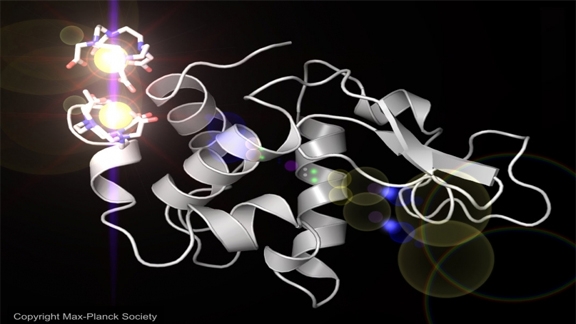Many people enjoy jigsaw puzzles, particularly at this time of year. Those who can put together 499 or 999 pieces (yes, there’s always one missing) with ease often turn to even greater challenges such as 3-D buildings or towers.
Puzzles fascinate scientists. Recently, a team of researchers working at the Energy Department’s SLAC National Accelerator Laboratory (SLAC) used its X-ray laser and significant computing power to solve one of nature’s most challenging jigsaws in practically a flash.
Those puzzles are the structure of proteins. Proteins serve as a cell’s machines and structural elements, and how they are shaped is a pretty good clue to what they do. Moreover, many medicinal molecules have been found — or designed — to turn particular proteins on or off, and therefore treat particular diseases, in much the same way a key goes into a lock.
However, protein puzzles are often very difficult to solve. They’re typically built from chains of hundreds of amino acids (the equivalent of puzzle pieces), and have many different components such as loops and helices. Large proteins may be built from many smaller ones or wrapped through a cell’s membrane multiple times, which makes them even tougher to crack.
To solve those structures, researchers typically have to spend days, and even years, trying to grow large protein crystals, which can then be analyzed. It’s a painstaking process of testing and growing, measuring and modeling. In some cases, it may simply be impossible to grow a crystal of sufficient size to ‘see’ the structure.
Researchers want to solve more of those protein puzzles, and solve them faster, and that’s where SLAC’s X-ray laser, the Linac Coherent Light Source (LCLS) comes in. The LCLS is the world’s most powerful X-ray free-electron laser, using a kilometer-long linear accelerator to produce strobe-light pulses of X-rays so fast that they can capture the motions of molecules and so powerful that they can reveal infinitesimal details of proteins … right before exploding the sample.
Coupled with sophisticated sensors and serious computing power, the LCLS can be used to pull detailed structural information from protein crystals scarcely the size of a speck of dust (a micron) and even smaller. Its ultrafast beam permits the relatively rapid processing of thousands of those tiny crystals, data sets which researchers can then combine to build a composite picture of the full protein.
Scientists working at SLAC used these powerful new capabilities to — for the first time — generate a complete 3-D model of a protein without making use of any previous clue to its structure. Specifically, they used bursts from the LCLS and sophisticated computer analysis to produce an accurate model of lysozyme, a well-studied protein found in egg whites. Rather than waiting for larger crystals to grow, or needing other data sets to fill in gaps, they effectively assembled the entire protein puzzle from scratch.
Researchers believe that technique can be taken much further, to the point of using the LCLS to solve incredibly complex protein puzzles (especially membrane proteins) in fractions of the time it used to take. That, in turn, could open new possibilities for new medicines and even new materials.
Long after the jigsaws have gone back into the box, researchers at the National Labs will still be pulling possibilities out of protein puzzles.

